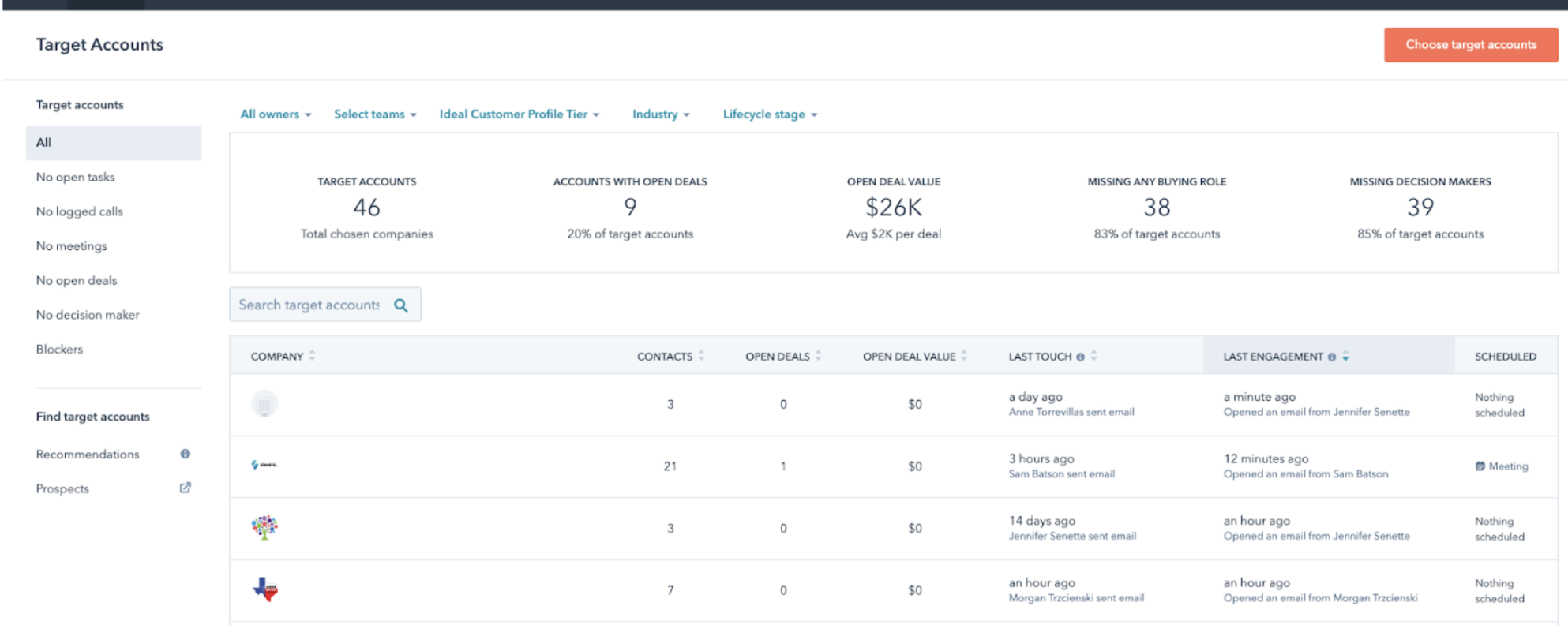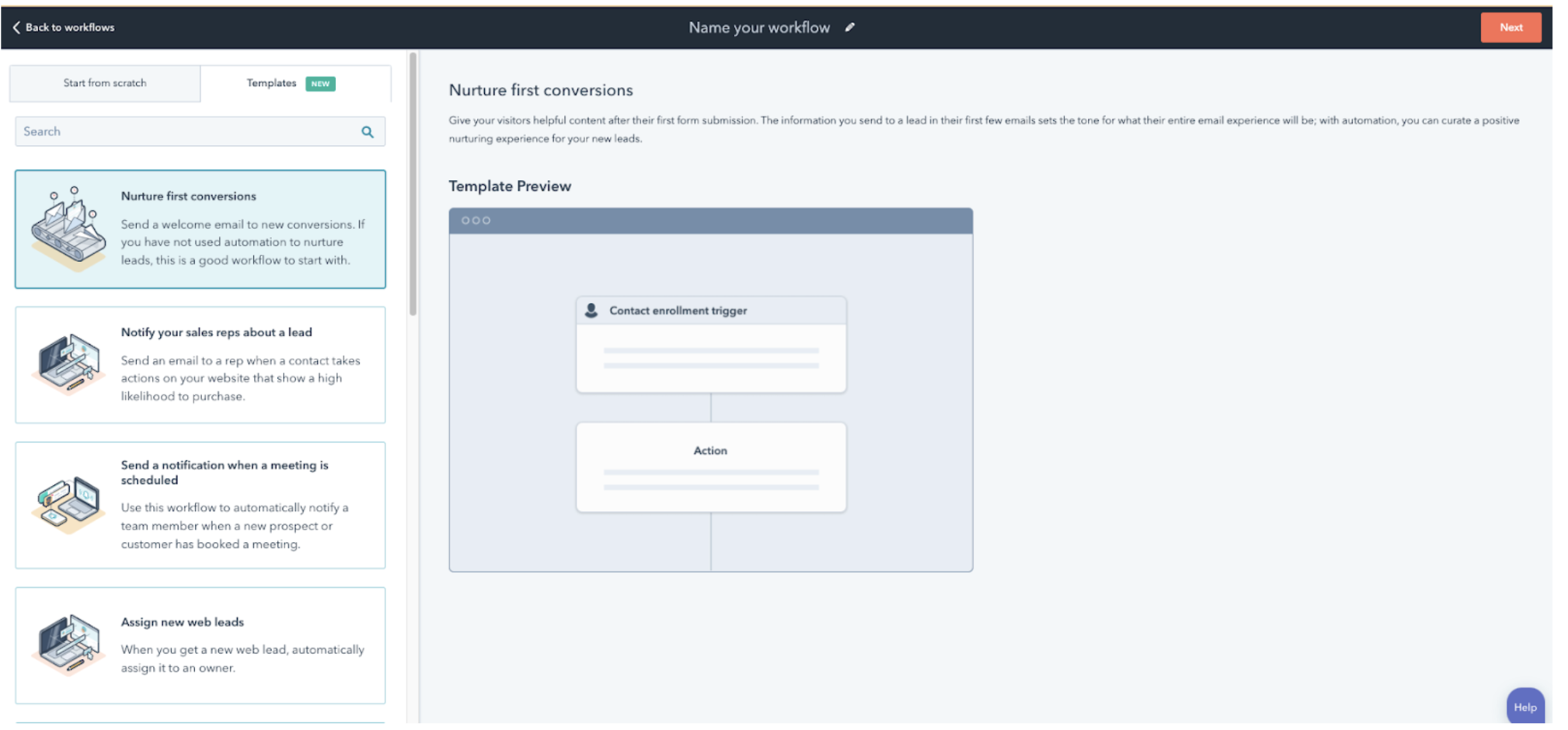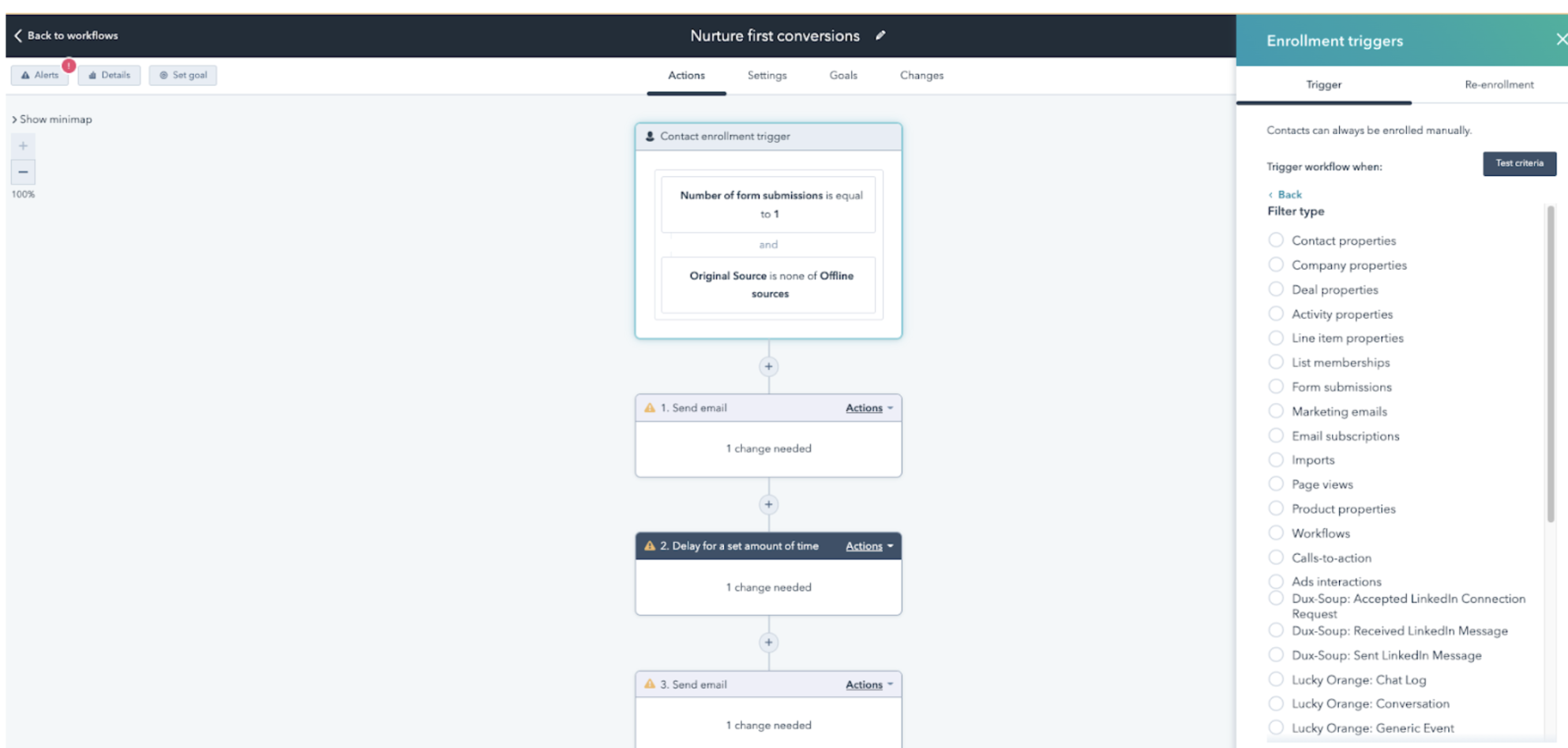Account-Based Marketing 101:
What it is, tools to consider, and how to execute a flawless campaign in HubSpot
Account based marketing (ABM) is a powerful tool in any marketer’s tool belt, especially if your annual contract value (ACV) is high and relative number of opportunities in your market are low.
Because ABM requires tight cooperation between marketing and sales, it is important that all involved have a common understanding of what it is and the tools and techniques needed to ensure ABM success. So let’s dive in!
ABM history
Where and when the practices ABM started can be debated, but we know for sure that the term was first introduced by the IT Services Marketing Association (ITSMA) in 2003, and then a groundbreaking 2004 paper titled Account Based Marketing: The New Frontier.
Despite ABM’s enduring presence as a marketing strategy (considering how quickly trends can come and go, at least!) it is still largely misunderstood by the modern marketer.
Here’s what ABM is not
In order to help us to understand what ABM is, let’s take a look at four things that ABM is not.
- Account based marketing is not a stand-alone practice that is mutually exclusive to other forms of marketing. It is a framework and a philosophy to place your tactics and strategies within. You can run inbound as a part of ABM. Demand generation can be a component of ABM. Webinars, content campaigns, and in-person events can all be a part of your ABM campaign.
- ABM is not demand generation with an account focus. Demand generation can be a complementary piece of your ABM campaign, but the two are not one and the same.
Demand generation focuses on driving demand rather than leads and requires sales and marketing to work together on lifecycle stage definitions and handoffs, so while it is a natural fit within the ABM framework, it is not the same thing. - ABM and using intent data are not one and the same. You can run ABM without intent data and you can use intent data without running an ABM play. Intent data helps you gain relevance in any marketing play, when deployed properly, but is not required to be relevant or personalized. Remember, ABM has been around since 2003, long before the ZoomInfos and Bomboras of the world were around to tell us our prospect’s every move.
- Account planning and ABM are not the same thing. Does ABM involve account planning? Yes. Does every team doing account planning have to run an ABM campaign? No. Account planning is a sales motion that can happen in a silo or in conjunction with marketing in order to market in line with the account planning done by sales.
So what is ABM?
Account-based marketing is a hyper-personalized marketing practice that aligns marketing and sales in the pursuit of selling to target accounts. They do this by building value across a segment of stakeholders who make up a buying committee.
By being hyper customer-centric, brands become reliable and trusted by their target accounts.
Since marketing and sales are so closely synced, the customer experience is seamless and relevant to their place in the buyer’s journey. From the very first impression at top of funnel (ToFu) to the assets that sales uses in the discovery process and beyond, marketing and sales are in lockstep.
This alignment and customer obsession – as well as the tactics and strategies you deploy – are what make ABM so effective.
ABM acronyms & jargon explained
Marketing and sales are two disciplines full of jargon and acronyms. If you’re running an ABM play, it’s smart to ensure both teams are clear about what is meant when ABM buzzwords inevitably start getting thrown around. Here are seven you’ll want to know:
- TAL - Target Account List. This is a list of accounts that you have identified as high-value that you will target in your campaigns. This can be done by choosing individual accounts or by using your ICP to find accounts that match those parameters
- ICP - This is your ideal customer profile. The ICP is usually created using a combination of firmographic, technographic, and demographic factors and is an essential guide to whether an individual account is one you should target or not. Many companies use ICP tiers to guide marketing and sales tactics & strategies based on tier or how valuable the account is to your business
- Buying Committee - this is the group of stakeholders that you are seeking to influence within your ABM campaigns because they have a seat at the decision making table. Potential buying committee members include decision makers, influencers, budget holders, blockers, champions, legal, and end users.
- Air Cover - This is a marketing play where you ensure that the buying committee is seeing relevant ads throughout the buyer’s journey. Air Cover is designed to ensure you are omni-present and to influence multiple people at your target accounts.
- Surfacing Leads or Handoffs - This is a sales and marketing alignment term that speaks to the timing and mechanisms for putting a lead in front of your sales team. For example, you may put your tier 1 target accounts in front of sales via a task and a Slack notification when the target account has a company score of 100.
- Thought Leadership - This term is applicable to other forms of marketing, but it is especially important in ABM. Thought leadership is a demonstration of your expertise on a particular topic. In ABM, this expertise is shared via social media posts, video content, podcasts, guides, and other content assets. Thought leadership helps you to position yourself while also providing value to your target accounts.
- Sales & Marketing Alignment - Necessary for running ABM plays, sales and marketing alignment involves sales and marketing collaborating on accounts to target, when to hand off those accounts based on ICP tier, lifecycle stage definitions, what content sales should use for various target accounts, and more. Sales and marketing alignment is about breaking down silos and making your revenue team more effective through working together.
So you’re sold on ABM…now what?
While ABM campaigns can be complex, setting up a solid foundation for your campaign is pretty simple if you follow the steps below:
- Identify your ICP, create your TAL, & segment your TAL into tiers - Any good marketing strategy starts with the audience. Who are you targeting? Whether you start with a hand-selected list of accounts or use your ICP parameters to pull a matched list from a 3rd party tool, the first step is to identify who you are targeting and to segment that list as necessary.
- Plan touchpoints and triggers per tier and/or buying role - Now that you know who you are targeting, you need to build out the buyer’s journey for each ICP tier, buying role, job function, etc. We recommend doing this with a tool like LucidChart or Miro.
- Remember, you will want to plan out all of your triggers, conditions, exclusions, lifecycle stage qualifications, etc. Make your schematic or roadmap as complete and thoughtful as possible. You are better off keeping your campaign simple than incomplete. Keep your team’s bandwidth in mind when deciding how segmented and personalized to be in your campaigns.
Tools needed to run an effective ABM campaign
There are dozens of tools that enable ABM - here’s a look at a few:
HubSpot - CRM, Marketing Automation, ReportingHubSpot allows you to run your ABM campaigns end-to-end right inside of your CRM. The fact that you can keep your data clean, ensure account visibility across marketing and sales, and scale your campaign with epic automations make HubSpot a great choice to be the backbone of your ABM campaigns.
RollWorks - Customer Intent Data, Marketing Automation, Reporting, Ad Delivery, AI Optimization
RollWorks can be used as a stand-alone platform, but it is best used in conjunction with a CRM like HubSpot. RollWorks provides customer intent data and a bevy of firmographic, demographic, and technographic data points to use when building out your ICPs and TALs. It then allows you to deploy those audiences through multiple channels, ensuring your messaging is relevant for buyers no matter where they are in their journey.
Terminus - Customer Intent Data, Marketing Automation, Reporting, Ad Delivery, AI Optimization
Terminus, like RollWorks, aims to cover the complete ABM cycle in one platform and conveniently plugs into a CRM like HubSpot. When you combine Terminus’ omni-channel personalization capabilities and intent data with your HubSpot record activity, segmented lists via automation, and other CRM data, you empower your marketing team to deliver customized account-based experiences at scale.
DemandBase - Customer Intent Data, Marketing Automation, Reporting, Ad Delivery, AI Optimization
DemandBase was built with B2B and ABM in mind. Seeking to unite account-based motions across the entire flywheel (a practice known as ABX), DemandBase provides an easy-to-use tool that assists with account selection, targeting, ad delivery, and omni-channel optimization for better ABM outcomes. With a hefty list of integrations, DemandBase is well positioned to partner with your CRM to deliver highly relevant content and campaigns.
We believe HubSpot is one of the best platforms to start with for ABM
HubSpot was built around the same customer-obsessed ethos from which ABM was born, so it makes sense that it’s a natural fit for ABM campaigns.
The HubSpot CRM platform connects all of the data from your sales and marketing efforts while allowing for robust, customer-centric automation and personalization. With an ABM campaign powered by HubSpot’s powerful CRM platform, you’re empowered to use data to segment and target your accounts and automation to nurture your buying committee and to hand warm leads over to sales. But that’s not all – check out the following HubSpot features that align with the tenants of successful ABM:
Single Source of Truth
- Shared view of all object records
- ABM tools
- Default ABM properties
- Target accounts home
- AI-powered Target Account recommendations
- Account overview page
- Operations Hub for data cleanliness and consistency
Streamlined Campaign Deployment
- Ads – company targeting
- Forms – company properties
- Smart content
- Landing pages
- Campaigns
- Workflow automations
- Company lists
Integrations Galore
- Slack for account based collaboration
- io for offline marketing & gifting
- ZoomInfo for contact enrichment
- Bombora for intent data
- Zoom for webinars
- Clearbit for account enrichment
- LinkedIn Sales Navigator for account planning & building
- Enhanced Salesforce sync for ABM
Seamless Handoffs = Seamless Customer Experience
- Advanced sequences
- Company scoring
- Marketing automation: lifecycle stage and lead status management
- Lead rotation
- Tasks and notifications
- Custom behavioral events
- Lead scoring
- Chat bots/live chat
- Default workflows
- Quotes
- Tasks
- Meetings
- Documents
- HubSpot video
Reporting and Revenue Attribution
- Custom reports
- Sales and marketing analytics
- Dashboards for ABM, sales, and marketing
- Conversational intelligence
- Ad conversion events
- Web, ad & social media analytics
Executing ABM campaigns in HubSpot
We have covered a lot of ground at this point, so let’s jump into the deep end and take a look at some specific ways you can leverage HubSpot’s Sales Hub and Marketing Hub to power your ABM plays:
- Create a target account list by adding AI-suggested target accounts, viewing prospects in the prospect tool, or importing target accounts using an integration with a third party tool like LinkedIn Sales Navigator, ZoomInfo, Bombora, Terminus, or RollWorks
- Track & view account activity in the account overview panel to view all touches and interactions across the entire buying committee in one place, ensuring both sales and marketing have a clear understanding of the state of each target account.

- Use workflows to label your ICP tiers and buying roles, and use company lists to group your target accounts and buying committee to leverage with company targeting in your campaigns
- Use the campaigns tool to plan and deploy all of the touches and asset iterations for your AMB plays. Social media, ads, landing pages, forms, emails, and much more can be added to a campaign to roll up reporting & results into one view across multiple assets
- Use smart content and A/B testing on your landing pages to give a personalized experience, and leverage chat bots to ensure your prospects can find what they need
- Use workflows and 3rd party integrations to continuously segment your lists and to update an account’s ad and other targeting based on engagement, intent, scoring, etc.
- Update lifecycle stage and lead status based on behavior or custom events and sync your lifecycle stages with external ad platforms for better AI optimization for your ad campaigns


- Automatically update marketing plays based on buying role, ICP tier, buying stage, and more using workflows
- Use workflows and company scoring to surface accounts to sales at the right time and keep sales in the know, moment by moment, of account activity using the Slack integration
- Use Operations Hub data quality features to ensure that all data syncing between tools is clean and consistent
- Automate the work of your sales team by leveraging workflows to assign tasks and send notifications
- Research active prospects and accounts with the LinkedIn Sales Navigator integration right inside of HubSpot and make your outreach timely and relevant
- Enroll buying committee members into sequences automatically based on any of over a thousand trigger options. Essentially, any information about the account can be utilized to determine the right time to enroll an account into a sequence
- Suggest content for sales to use in the buying process based on prospect’s consumption history using workflows and user behavior data to personalize the journey
- Use HubSpot videos in your sales outreach for personalization
- Use workflows and offline marketing integrations like postal.io to automatically send gifts to your buying committee based on deal size, ICP tier, lifecycle stage, deal stage, and more
- Analyze data across the entire buyer’s journey in one place with reports and dashboards, collaborate on changes with the campaign tool, and implement iterations and optimizations into your campaigns all from HubSpot.
In summary, if you’re running ABM, consider HubSpot your one-stop shop
The benefits of using HubSpot for account based marketing plays are plentiful. It’s the best-in-class platform for ABM for the following reasons:
- Keep your team in one reliable, trusted tool with a shared view of company, contact, and deal records
- Transparency from start to finish to keep teams aligned
- A powerful workflow automation tools to give your customers a seamless experience
- Plentiful integrations to add functionality and customer data to your campaigns
- Personalize the buyer’s journey, account by account and buying role by buying role
- Build out your entire strategy in HubSpot for smooth handoffs using native ABM tools
- Analyze and iterative on the spot for increased success over time with reporting and analytics
- Attribute your results to your marketing efforts with omni-channel activity tracking
Ever think about combining your inbound strategy with ABM?
Inbound and ABM go together like peas and carrots. Both based on delighting the customer and driving value first, it is no wonder that so many marketers combine these two practices for digital marketing bliss. What makes these two approaches so complementary? Think about it:
- Inbound focuses on giving the customer what they want and need at each step of the buyer’s journey – it is buyer-centric.
- ABM focuses on using deep account knowledge to personalize the buyer’s journey at scale, focusing on an entire account/buying committee.
- ABM requires sales and marketing alignment and allows sales to spend more time on the right leads.
- When you put these two practices together, you deliver an experience that makes prospects delight in interacting with your brand.
If there's ever been a time to thoughtfully and consistently communicate with the brands or businesses you would like to work with, it is now. Using a targeted approach to find accounts and market to them so everyone in the entire business is brought in to the process, ABM is your go-to strategy for an collaborative approach to sales.
